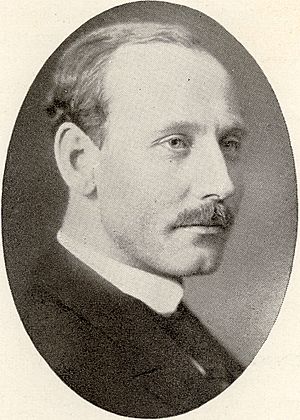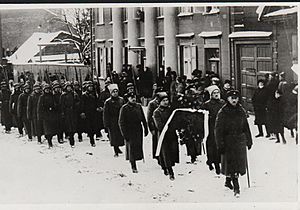Kaarel Eenpalu facts for kids
Quick facts for kids
Kaarel Eenpalu
|
|
|---|---|
 |
|
| 13th State Elder of Estonia | |
| In office 19 July 1932 – 1 November 1932 |
|
| Preceded by | Jaan Teemant |
| Succeeded by | Konstantin Päts |
| Acting Prime Minister of Estonia | |
| In office 24 April 1938 – 9 May 1938 |
|
| President | Konstantin Päts |
| Preceded by | Konstantin Päts As President-Regent |
| Succeeded by | himself as Prime Minister |
| 7th Prime Minister of Estonia | |
| In office 9 May 1938 – 12 October 1939 |
|
| President | Konstantin Päts |
| Preceded by | himself as Acting Prime Minister |
| Succeeded by | Jüri Uluots |
| Personal details | |
| Born | 28 May 1888 Vesneri Parish, Tartu County, Livonia, Russian Empire |
| Died | 27 January 1942 Kirov Oblast, Soviet Union |
| Political party | Estonian People's Party |
Kaarel Eenpalu was an important Estonian politician, journalist, and leader. He was born on May 28, 1888, in Vesneri Parish, Estonia. His original name was Karl August Einbund, but he changed it in 1935. He served as the 7th Prime Minister of Estonia. Sadly, he died in a Soviet prison camp in Russia on January 27, 1942.
Contents
His School Days
Kaarel Eenpalu went to school at the Hugo Treffner Gymnasium in Tartu. This was a well-known school. Later, he studied law at the University of Tartu from 1909 to 1914. He also graduated from Moscow State University.
A Career in Journalism
Eenpalu was very active in the world of newspapers. From 1910 to 1912, he worked on the editorial team of the Postimees Daily in Tartu. He returned to Postimees as an editor in 1918. In 1920, he became the editor-in-chief of the Tallinna Teataja daily. Later, in 1924, he was the editor-in-chief of the Kaja newspaper.
Serving in Wars

Kaarel Eenpalu played a role in both World War I and the Estonian War of Independence. In World War I, he was a battery commander in the First Estonian Artillery Regiment. This was between 1917 and 1918.
During Estonia's fight for freedom (1918–1919), he led a battalion of high school students from Tartu. After that, he commanded a battery in the Second Estonian Artillery Regiment.
A Life in Politics
Eenpalu was a key figure in the new independent Estonian state. He was a member of the Estonian Constituent Assembly from 1919 to 1920. He also served in the National Assembly, called the Riigikogu, from 1920 to 1937. Later, he was part of the Chamber of Deputies starting in 1938.
He held many important government jobs:
- From 1919 to 1920, he was the State Controller.
- He served as the Minister of Internal Affairs multiple times: in 1920, from 1921 to 1924, and from 1924 to 1926. Because of this, he is seen as one of the founders of the Estonian Police force.
- From 1926 to 1932, and again from 1933 to 1934, he was the Speaker of the Riigikogu.
- From July to November 1932, he was the head of state, known as the Riigivanem (State Elder).
- He was again Minister of Internal Affairs from 1934 to 1938.
- Finally, from 1938 to 1939, he served as the Prime Minister of Estonia.
His Capture and Death
After the Soviet Union took control of Estonia on June 17, 1940, Kaarel Eenpalu was arrested. This happened in July 1940. He was then sent away to Russia. He died in 1942 in a Soviet prison camp. The camp was located in Kirov Oblast, Russia.
Awards and Recognition
Kaarel Eenpalu received several important awards for his service to Estonia:
- 1927 – Order of the Estonian Red Cross I/II
- 1930 – Order of the Cross of the Eagle I
- 1935 – Order of the Estonian Red Cross I/I
- 1938 – Order of the White Star I
- 1939 – Order of the National Coat of Arms I
His Family
Kaarel Eenpalu was married to Linda Eenpalu, who was also a women's activist. They had four daughters: Helmi-Aino (born 1917), Virve (born 1919), Tiiu-Hilja (born 1921), and Mai-Linda (born 1923). His granddaughter, Anne Eenpalu (born 1954), is also a politician.

